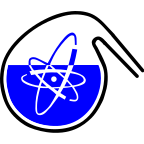Speakers
Description
Liquid extraction is widely used in radiochemistry for the concentration and separation of elements. When the organic phase containing the extragent contacts with the aqueous phase in which contains element the reactions occur in the interfacial layer. As a result of the reactions, several compounds are formed, among which there are often those that do not directly pass into either the organic or the aqueous phase. Their molecules accumulate in the interfacial layer, aggregate and coagulate forming cruds. At a certain ratio of the quantities of the extracted element and the extragent, a precipitate is formed that can sediment to the bottom of the vessel or settle in pipelines connecting the extractor with other processing equipment. Interfacial formations have a negative effect on the extraction of the element.
This report presents the results of studies on the formation of interfacial formations in the extraction of rare-earth elements (REE) by solutions of di- (2-ethylhexyl)phosphoric acid (D2EHPA).
The resulting di-(2-ethylhexyl)phosphate lanthanide (has some surface activity) is able to accumulate in the dynamic interfacial layer (DIL) of the extraction system. Over time, the accumulation of REE in the DIL increases. The processes of aggregation, coagulation and polymerization are proceeding, as indicated by the absorption at 1180 cm-1 and 1090 cm-1 in IR spectra of interfacial formation. These indicate the presence of bridge alkylphosphate groups in linear polymers. The formation of structure in the DIL leads to the appearance of interfacial formations, the mechanical strength of which is not great for both the elements of the yttrium and the cerium subgroups. However, in the case of elements of the cerium subgroup, the interfacial formations deforms reversibly, and in the case of elements of the yttrium subgroup it is partially destructed (for example, when heptane is used as a diluent of D2EHPA).
Kinetic curves of accumulation of REE in the DIL are characterized by the presence of a region when the accumulation of a REE remains constant. The length of this region and its position on the kinetic curve of accumulation depends on many factors (the concentration of REE and extraction reagent, acidity of the medium, the nature of REE and diluent of the extragent). The amount of the REE accumulating in the DIL depends on these same factors. In the heptane system used as the diluent of the extragent, when Er(III) is extracted from the chloride solution, the accumulation is higher (23% at the time of 60 min) than in the system with toluene being the more polar diluent (12% to this same time). A region with a constant value of accumulation of a REE in the DIL is short, often weakly expressed and observed almost at the very beginning of the experiment (5-7 min). In systems with toluene, the region with a constant value of accumulation is well expressed, longed (1540 min) and at a lower degree it depends on the concentration of the extragent. An increase in the concentration of D2EHPA and a decrease in the concentration of the REE, all other things being equal, lead to a decrease in the accumulation of the REE in the DIL. The obtained dependences can be explained by the change in the intensity of interfacial phenomena, of which spontaneous surface convection is important.
Thus, the formation of interfacial formations in the DIL is due to chemical reactions, adsorption, formed molecules, their aggregation and polymerization, partial emulsification, in view of the appearance and development of spontaneous surface convection, the phase separation and the formation of structure.

